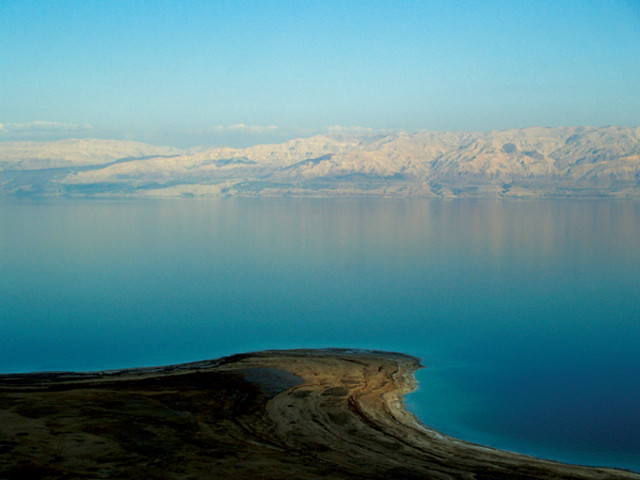
by Terri Cook Wednesday, July 19, 2017

The Dead Sea region experienced at least two droughts in the past 200,000 years that were far worse than any in recorded human history. Credit: David Shankbone, CC BY-SA 3.0.
The Dead Sea, a landlocked lake bordered by Israel, Jordan and Palestine, is nearly 10 times saltier than the ocean. And it’s getting saltier. Since the beginning of the 20th century, the water level has dropped by nearly 30 meters, largely because of diversions of the Jordan River, the lake’s primary tributary and the arid region’s main source of fresh water.
Climate models are predicting increasing dryness across the eastern Mediterranean, which could further stress regional water supplies. But the severity of these droughts is debated. In a new study published in Earth and Planetary Science Letters, researchers studying thick intervals of crystallized salt in sediment cores collected from beneath the Dead Sea have found that the region has experienced droughts far worse than any in recorded human history.
The cores, drilled to a depth of 456 meters below the seabed and recovered from 2010 to 2011 as part of the International Continental Scientific Drilling Program’s Dead Sea Deep Drilling Project, are composed of alternating layers of mud and salt that constitute an archive of regional climate history extending back about 200,000 years — the longest such record in the Middle East. The Dead Sea’s very high sedimentation rate allows scientists to use the cores to characterize past changes in climate at the resolution of just a few decades, says Yael Kiro, a geochemist at Columbia University’s Lamont-Doherty Earth Observatory and lead author of the study.
Analyzing the modern Dead Sea’s salt and water budgets, the researchers determined that dissolved minerals entering the lake from external sources only account for 1 millimeter of salt precipitation per year. Because salt sedimentation rates observed in the core are typically 0.5 to 3 centimeters per year, much of the salt that precipitates must do so as a result of dropping lake levels during drying conditions, Kiro says. Mud in Dead Sea sediments, by contrast, is washed into the lake during intervening wetter periods.
By measuring the composition of tiny pockets of ancient brine trapped within salt crystals and between sediment grains, the team estimated that 12 to 16 centimeters of salt piled up for every meter the lake level dropped The researchers used this estimate to reconstruct a record of Dead Sea water levels during periods of salt deposition and then extrapolated regional rainfall and runoff patterns.
The findings indicate that in the past 200,000 years, inflows of water into the Dead Sea have decreased dramatically at times, causing its level to drop about 170 meters during the last interglacial peak 130,000 to 115,000 years ago, when average global temperatures were higher than today, and again from about 10,000 to 6,000 years ago following the most recent ice age. These declines dropped the water surface about 80 meters lower than levels observed during typical interglacial episodes.
During these massive water level drops, Kiro says the average volume of runoff into the Dead Sea decreased by half and, at times, plummeted to as little as 20 percent of prediversion (1964) levels. “Our conclusion,” she says, “is that the climate was highly variable … but on average it was significantly drier” during these periods.
Whereas most assessments of the effects of climate change on water resources are generally based on observations from past decades and on climate models, Kiro says, the Dead Sea cores provide “an independent estimate” of the effect of warming on past precipitation in the Middle East. This record shows this region was much more water stressed at times in the past than present models have suggested, she says. “We know now that the climate in this sensitive region of the Eastern Mediterranean was very dry. This may serve as an analogue for future warming.”
The findings in the new study “provide an important step forward regarding our understanding of Middle Eastern climate during periods as warm, or warmer than, today,” says Thomas Felis, a senior scientist at the University of Bremen in Germany, who was not involved in the study. “This region of the world is characterized by an unusual variety of natural archives that document past climate change,” he says. Altogether, these “provide a unique opportunity to study the complex interactions of different aspects that affected past climate in this region, in order to provide more reliable estimates of future climate change.”
© 2008-2021. All rights reserved. Any copying, redistribution or retransmission of any of the contents of this service without the expressed written permission of the American Geosciences Institute is expressly prohibited. Click here for all copyright requests.